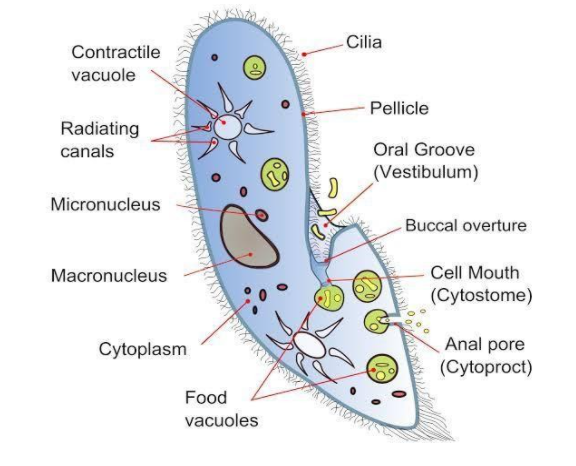
The cilia in Paramecium are
A. All equal
B. All unequal
C. Longer at the posterior end
D. Longer at the anterior end
Answer
459k+ views
Hint: The Paramecium is a eukaryotic single-celled organism that varies from thirty to three hundred micrometres in length. The entire body of the Paramecium is enclosed in small hair-like filaments known as the cilia.
Complete answer: The Paramecium is a member of the phylum Protozoa and class Ciliata. They are also termed as slipper animalcules. They are a single-celled eukaryotic organism that possesses two kinds of nuclei.

The four species of Paramecium are:
a) Paramecium caudatum
b) Paramecium aurelia
c) Paramecium multimicronucleatum
d) Paramecium bursaria or Green bursaria
The cilia that are present in the Paramecium helps in moving or locomotion. It also plays a vital role in the organism to move food to the oral cavity. The cilia are arranged uniformly over the body in longitudinal rows. These rows are equidistant over the entire body. The presence of cilia on an organism is also termed as holotrichous. Also, the cilia are composed of the plasma membrane that has longitudinal fibrils. They are moderate and are nearly uniform in length, but at the posterior end, cilia are quite larger and longer called caudal tufts. These longitudinal fibrils are of two types, namely the inner fibrils and the outer fibrils. The inner fibrils are much thinner than outer fibrils.
Hence, the correct answer is option C.
Note: The Paramecium possesses two types of nucleus. These two types are termed as the micronucleus and the macronucleus. The micronucleus is the reproductive nucleus, whereas the macronucleus is defined as the vegetative nucleus. Also, the micronucleus is categorised into two nuclei by the process of mitosis, and the macronucleus splits into two parts.
Complete answer: The Paramecium is a member of the phylum Protozoa and class Ciliata. They are also termed as slipper animalcules. They are a single-celled eukaryotic organism that possesses two kinds of nuclei.

The four species of Paramecium are:
a) Paramecium caudatum
b) Paramecium aurelia
c) Paramecium multimicronucleatum
d) Paramecium bursaria or Green bursaria
The cilia that are present in the Paramecium helps in moving or locomotion. It also plays a vital role in the organism to move food to the oral cavity. The cilia are arranged uniformly over the body in longitudinal rows. These rows are equidistant over the entire body. The presence of cilia on an organism is also termed as holotrichous. Also, the cilia are composed of the plasma membrane that has longitudinal fibrils. They are moderate and are nearly uniform in length, but at the posterior end, cilia are quite larger and longer called caudal tufts. These longitudinal fibrils are of two types, namely the inner fibrils and the outer fibrils. The inner fibrils are much thinner than outer fibrils.
Hence, the correct answer is option C.
Note: The Paramecium possesses two types of nucleus. These two types are termed as the micronucleus and the macronucleus. The micronucleus is the reproductive nucleus, whereas the macronucleus is defined as the vegetative nucleus. Also, the micronucleus is categorised into two nuclei by the process of mitosis, and the macronucleus splits into two parts.
Recently Updated Pages
How do you factor x2 + x 20 0 class 9 maths CBSE

How do you solve y6x and 2x+3y20 using substitutio class 9 maths CBSE

Chipko movement originated in Gopeshwar in A 1953 B class 9 biology CBSE

The adjacent sides in the parallelogram are supplementary class 9 maths CBSE

The compound used in plastic industry is A Vinyl acetate class 9 chemistry CBSE

How do you solve for y in 2left y dfrac12 right 4left class 9 maths CBSE

Trending doubts
According to Bernoullis equation the expression which class 11 physics CBSE

Draw a diagram of nephron and explain its structur class 11 biology CBSE

Differentiate between calcination and roasting class 11 chemistry CBSE

A solution of a substance X is used for white washing class 11 chemistry CBSE

What is spore formation class 11 biology CBSE

10 examples of friction in our daily life




